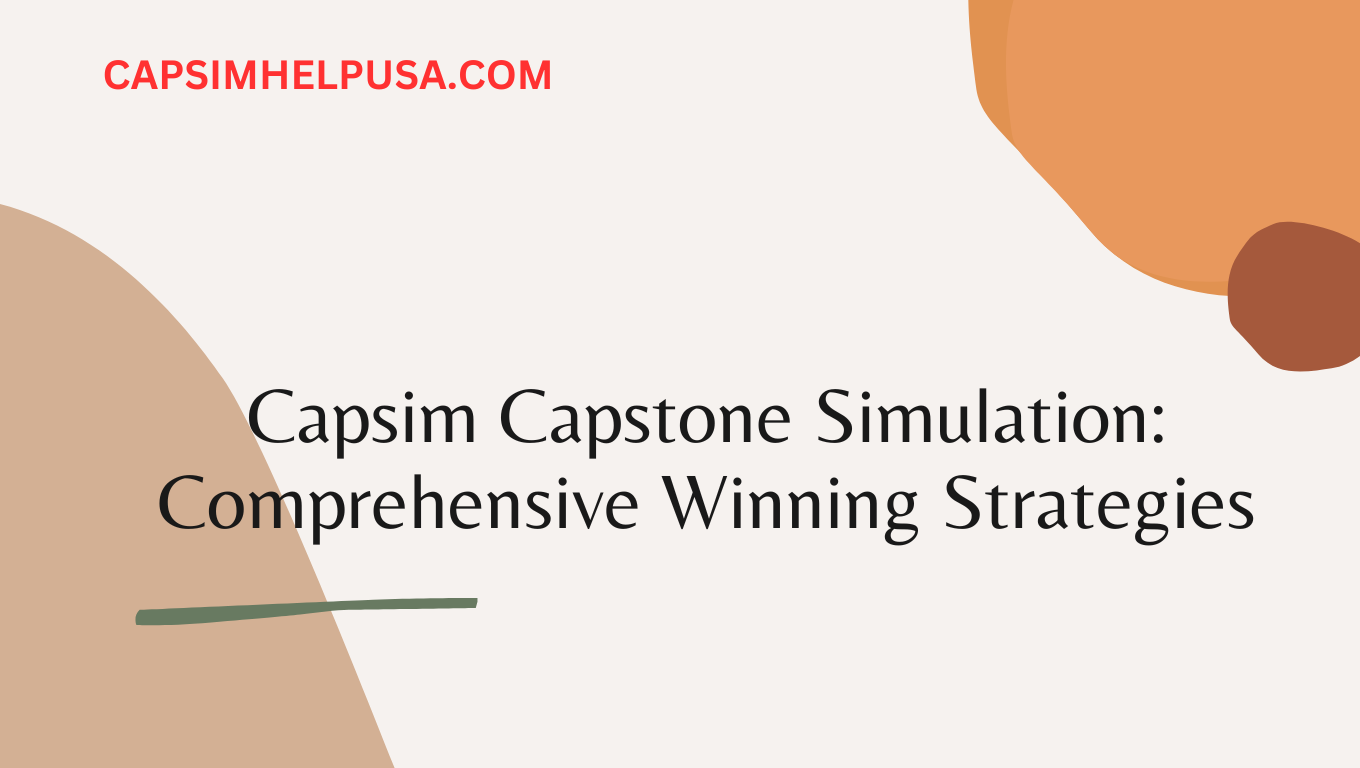Capsim Capstone Simulation: Comprehensive Winning Strategies
Published by Rabia B. @

Table of Contents
Competing in a Capsim Capstone simulation demands a strong grasp of company operations and the ability to make strategic decisions in a variety of functional domains. The simulation simulates real-world situations where choices about product creation, cost, promotion, manufacturing, and funding must be made.
R&D (research and development)
In Capsim, R&D serves as the cornerstone of product strategy. By using R&D, you may customize your products to fit the needs of various client segments and maintain control over their design, quality, and marketability. Being ahead of the curve in R&D implies striking a balance between cost and innovation.
Important Techniques:
Product Innovation and Repositioning: Always reinvent your items per consumer demands. The simulation's several consumer segments—such as the Low-End, Traditional, and High-End—have varying demands in terms of size, dependability, and performance. Utilize R&D to modify the placement of your items to meet these evolving needs. To capitalize on expanding market niches, you can create brand-new items, update existing models, or add new features.
Timing is Crucial: The timing of product releases is crucial. While waiting too early could result in resource waste, waiting too long could give your rivals an advantage. Align your cycles of research and development such that new releases can be made just before or during periods of high consumer demand.
Equitable R&D Expenditure: Although spending a lot of money on R&D could result in better products, cost control is crucial. Profits can be reduced by excessive investment, particularly in market niches where consumers are price-sensitive. Spend money in a way that is strategic and innovative without going overboard with what customers expect.
Marketing
Your marketing plan in Capsim will have a direct impact on how well you sell. Pricing, promotion, and sales forecasting are all aspects of marketing decisions that have an impact on how consumers view and buy your goods.
Precise Sales Forecasting: Precise sales forecasting is essential in Capsim since it guides your financial and production planning.
Competitive Pricing: Different market groups have varying degrees of sensitivity to price. For instance, the Low-End market is extremely price-sensitive, thus lowering your pricing even a little bit could boost your market share. On the other hand, because of its emphasis on performance and quality, the High-End market may be able to afford premium pricing. Recognize the price elasticity of your market and modify pricing appropriately.
Advertising and Promotions: While sales promotions might boost short-term sales, advertising raises client awareness of your products. It's critical to weigh the possible benefits of these endeavors against their expenses. Strategic use of promotions is advised, possibly during the introduction of a new product or during times of intense competition. Maintaining brand recognition can be greatly aided by advertising, particularly in areas with intense competition. Accessibility and Brand Recognition: Make sure you retain or increase product accessibility and brand awareness as your business expands. Elevated cognizance results in robust client identification, whereas reachability guarantees that buyers can conveniently locate and acquire your offerings.
Plan of Production
Production choices affect your organization's effectiveness as well as your capacity to satisfy consumer demand. Lower costs are the outcome of effective production management, but inefficiencies and lost opportunities can be caused by insufficient planning.
Capacity Planning: Deciding how much capacity to construct and maintain is one of the most important production choices. Achieving a balance between investing too much in manufacturing facilities that will remain idle and having sufficient capacity to fulfill anticipated demand is crucial. While insufficient capacity can result in lost sales opportunities, excess capacity can reduce earnings through needless fixed costs.
Inventory Management: The topic of inventory management is closely associated with capacity planning.
Automation Investments: Over time, increasing automation in your manufacturing plants can save labor costs and boost output efficiency. It's imperative to plan for automation early in the simulation because it requires a long-term commitment. High levels of automation, however, may make it more difficult for you to quickly modify output in response to changes in client preferences, so carefully weigh the trade-offs.
Further Thoughts:
adaptability vs. Cost Efficiency: It's important to strike a balance between automation and adaptability. At a higher cost, low automation allows you to swiftly adjust your production plan in response to market demands. While high automation increases productivity, it also forces you to use a set production configuration.
Outsourcing and Production Efficiency: If it makes financial sense, think about outsourcing some production procedures as the simulation goes on. You can concentrate on your core skills through outsourcing, which may also lower your production expenses. Automation and Cost Savings: As you proceed, think about how R&D choices may be impacted by manufacturing automation. Production costs can be reduced by creating products that are simpler to make or that need fewer components.
Financial Plan
Effective financial management is essential to your business's success in Capsim. Your financial well-being is impacted by every choice you make in R&D, marketing, and manufacturing, so knowing how to manage cash flow, borrowing, and investments is essential. Stock Buybacks: To boost shareholder value as your financial status improves, think about repurchasing shares. This can increase earnings per share and is particularly useful if your company's stock is cheap.
Human Resource Management
Human Resource Management
Staff Productivity and Training: To increase workforce productivity, fund staff training initiatives. Training makes sure that your staff members stay proficient and productive even as automation rises, which boosts output efficiency. TQM Investments: Programs for Total Quality Management (TQM) aim to increase labor efficiency, lower material costs, and improve product quality. These programs increase consumer satisfaction and decrease waste, which benefits your bottom line. Workforce Compensation: Competitive pay helps employers maintain top talent and enthusiastic staff. However, exercise caution to avoid overspending on compensation, as this may lead to needless expense increases.
Advanced Considerations: • Balancing Efficiency and Morale: Prioritize long-term methods that support employee morale and retain a productive staff.
Evaluation of Competition and Market Adjustment
Keeping a competitive edge requires regular analysis of market trends and competitor strategies. Competitive Benchmarking: Continually compare your business's product positioning, price, and market share to those of your rivals. This aids in finding chances to set your products apart from the competition or undercut them on price.
• Adjust to Market Shifts: Because the Capsim simulation is dynamic, both consumer preferences and market conditions will change over time. Remain adaptable and prepared to modify your plan in order to take advantage of these changes. For instance, you might need to reallocate resources to R&D and marketing in that category if there is an abrupt increase in demand for high-tech products. Advanced Considerations: • Strategic Alliances: Particularly in very competitive market sectors, forging alliances with rivals (for example, through joint ventures or partnerships) may occasionally enable you to pool resources and reduce risk.
Conclusion
In the end, success in the Capsim Capstone simulation necessitates a well-rounded strategy, long-term strategic planning, and the adaptability to take advantage of new possibilities and overcome obstacles. In the simulated business environment, you can lead your company to profitability, market leadership, and long-term sustainability by grasping each of these crucial elements and their interdependencies. A well-balanced approach to managing many business operations facets is essential for success in the Capsim Capstone simulation. In addition to focusing on specific functional areas like R&D, marketing, production, and finance, a successful strategy must also take a holistic approach to understanding how these areas interact to create total corporate performance. Marketing assists you in precisely targeting those customers by means of efficient pricing, promotions, and sales forecasting, while R&D enables you to create and customize your products to fulfill changing consumer demands. Automation is essential for cutting costs, and production management guarantees capacity planning and efficiency. Financial strategies, on the other hand, serve as the cornerstone for all choices, assisting you in managing debt, funding expansion prospects, and preserving liquidity.
Furthermore, by enhancing productivity and product quality, investments in TQM and human resources give you a competitive edge. Competitor analysis and market adaption help you remain flexible in the face of shifting circumstances. Sustained success can be achieved by your firm by having a thorough awareness of your competitors and the capacity to adapt to changes in the market.
If you are looking to get Capstone Simulation Help, contact us.





